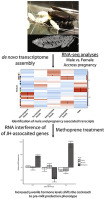当前位置:
X-MOL 学术
›
Insect Biochem. Mol. Biol.
›
论文详情
Our official English website, www.x-mol.net, welcomes your
feedback! (Note: you will need to create a separate account there.)
Molecular mechanisms underlying milk production and viviparity in the cockroach, Diploptera punctata.
Insect Biochemistry and Molecular Biology ( IF 3.2 ) Pub Date : 2020-02-28 , DOI: 10.1016/j.ibmb.2020.103333 Emily C Jennings 1 , Matthew W Korthauer 1 , Jacob M Hendershot 1 , Samuel T Bailey 1 , Matthew T Weirauch 2 , Jose M C Ribeiro 3 , Joshua B Benoit 1
Insect Biochemistry and Molecular Biology ( IF 3.2 ) Pub Date : 2020-02-28 , DOI: 10.1016/j.ibmb.2020.103333 Emily C Jennings 1 , Matthew W Korthauer 1 , Jacob M Hendershot 1 , Samuel T Bailey 1 , Matthew T Weirauch 2 , Jose M C Ribeiro 3 , Joshua B Benoit 1
Affiliation

|
Viviparous reproduction is characterized by maternal retention of developing offspring within the reproductive tract during gestation, culminating in live birth. In some cases, a mother will provide nutrition beyond that present in the yolk; this is known as matrotrophic viviparity. While this phenomenon is best associated with mammals, it is observed in insects such as the viviparous cockroach, Diploptera punctata. Female D. punctata carry developing embryos in the brood sac, a reproductive organ that acts as both a uterus and a placenta by protecting and providing a nutritive secretion to the intrauterine developing progeny. While the basic physiology of D. punctata pregnancy has been characterized, little is known about the molecular mechanisms underlying this phenomenon. This study combines RNA-seq analysis, RNA interference, and other assays to characterize molecular and physiological changes associated with D. punctata reproduction. A comparison of four stages of the female reproductive cycle revealed unique gene expression profiles corresponding to each stage. Differentially regulated transcripts of interest include the previously identified family of milk proteins and transcripts associated with juvenile hormone metabolism. RNA interference and methoprene application experiments reveal potential impacts of the breakdown and synthesis reduction of juvenile hormone in maintaining pregnancy in D. punctata. These studies provide the comprehensive molecular mechanisms associated with cockroach viviparity, which provide critical resource for comparative purposes among viviparity in insect systems.
中文翻译:

蟑螂Diploptera punctata中产奶和胎生的分子机制。
胎生生殖的特征是在妊娠期间母体将发育中的后代保留在生殖道内,最终达到活产。在某些情况下,母亲所提供的营养将超出蛋黄中提供的营养。这被称为自养胎生。虽然这种现象与哺乳动物最相关,但在昆虫中观察到了这种现象,例如胎生蟑螂,双翅目双翅目。雌性点子D. punctata在生殖囊中携带发育中的胚,生殖囊通过保护子宫内发育后代并为其提供营养分泌,同时充当子宫和胎盘。虽然已对点状点石pregnancy怀孕的基本生理特性进行了描述,但对该现象背后的分子机制了解甚少。这项研究结合了RNA序列分析,RNA干扰,和其他测定方法来表征与点状D虫繁殖相关的分子和生理变化。雌性生殖周期四个阶段的比较显示对应于每个阶段的独特基因表达谱。感兴趣的差异调节转录本包括先前鉴定的牛奶蛋白家族和与少年激素代谢相关的转录本。RNA干扰和甲基异戊二烯的应用实验揭示了幼体激素的分解和合成减少对维持点滴D的妊娠的潜在影响。这些研究提供了与蟑螂胎生有关的综合分子机制,为昆虫系统中胎生之间的比较目的提供了关键资源。点状繁殖。雌性生殖周期四个阶段的比较显示对应于每个阶段的独特基因表达谱。感兴趣的差异调节转录本包括先前鉴定的牛奶蛋白家族和与少年激素代谢相关的转录本。RNA干扰和甲基异戊二烯的应用实验揭示了幼体激素的分解和合成减少对维持点滴D的妊娠的潜在影响。这些研究提供了与蟑螂胎生有关的综合分子机制,为昆虫系统中胎生之间的比较目的提供了关键资源。点状繁殖。雌性生殖周期四个阶段的比较显示对应于每个阶段的独特基因表达谱。感兴趣的差异调节转录本包括先前鉴定的乳蛋白家族和与少年激素代谢相关的转录本。RNA干扰和甲基异戊二烯的应用实验揭示了幼体激素的分解和合成减少对维持点滴D的妊娠的潜在影响。这些研究提供了与蟑螂胎生有关的综合分子机制,为昆虫系统中胎生之间的比较目的提供了关键资源。感兴趣的差异调节转录本包括先前鉴定的乳蛋白家族和与少年激素代谢相关的转录本。RNA干扰和甲基异戊二烯的应用实验揭示了幼体激素的分解和合成减少对维持点滴D的妊娠的潜在影响。这些研究提供了与蟑螂胎生有关的综合分子机制,为昆虫系统中胎生之间的比较目的提供了关键资源。感兴趣的差异调节转录本包括先前鉴定的乳蛋白家族和与少年激素代谢相关的转录本。RNA干扰和甲基异戊二烯应用实验揭示了分解和减少幼体激素对维持点状D的怀孕的潜在影响。这些研究提供了与蟑螂胎生有关的综合分子机制,为昆虫系统中胎生之间的比较目的提供了关键资源。RNA干扰和甲基异戊二烯应用实验揭示了分解和减少幼体激素对维持点状D的怀孕的潜在影响。这些研究提供了与蟑螂胎生有关的综合分子机制,为昆虫系统中胎生之间的比较目的提供了关键资源。RNA干扰和甲基异戊二烯应用实验揭示了分解和减少幼体激素对维持点状D的怀孕的潜在影响。这些研究提供了与蟑螂胎生有关的综合分子机制,为昆虫系统中胎生之间的比较目的提供了关键资源。
更新日期:2020-03-02
中文翻译:

蟑螂Diploptera punctata中产奶和胎生的分子机制。
胎生生殖的特征是在妊娠期间母体将发育中的后代保留在生殖道内,最终达到活产。在某些情况下,母亲所提供的营养将超出蛋黄中提供的营养。这被称为自养胎生。虽然这种现象与哺乳动物最相关,但在昆虫中观察到了这种现象,例如胎生蟑螂,双翅目双翅目。雌性点子D. punctata在生殖囊中携带发育中的胚,生殖囊通过保护子宫内发育后代并为其提供营养分泌,同时充当子宫和胎盘。虽然已对点状点石pregnancy怀孕的基本生理特性进行了描述,但对该现象背后的分子机制了解甚少。这项研究结合了RNA序列分析,RNA干扰,和其他测定方法来表征与点状D虫繁殖相关的分子和生理变化。雌性生殖周期四个阶段的比较显示对应于每个阶段的独特基因表达谱。感兴趣的差异调节转录本包括先前鉴定的牛奶蛋白家族和与少年激素代谢相关的转录本。RNA干扰和甲基异戊二烯的应用实验揭示了幼体激素的分解和合成减少对维持点滴D的妊娠的潜在影响。这些研究提供了与蟑螂胎生有关的综合分子机制,为昆虫系统中胎生之间的比较目的提供了关键资源。点状繁殖。雌性生殖周期四个阶段的比较显示对应于每个阶段的独特基因表达谱。感兴趣的差异调节转录本包括先前鉴定的牛奶蛋白家族和与少年激素代谢相关的转录本。RNA干扰和甲基异戊二烯的应用实验揭示了幼体激素的分解和合成减少对维持点滴D的妊娠的潜在影响。这些研究提供了与蟑螂胎生有关的综合分子机制,为昆虫系统中胎生之间的比较目的提供了关键资源。点状繁殖。雌性生殖周期四个阶段的比较显示对应于每个阶段的独特基因表达谱。感兴趣的差异调节转录本包括先前鉴定的乳蛋白家族和与少年激素代谢相关的转录本。RNA干扰和甲基异戊二烯的应用实验揭示了幼体激素的分解和合成减少对维持点滴D的妊娠的潜在影响。这些研究提供了与蟑螂胎生有关的综合分子机制,为昆虫系统中胎生之间的比较目的提供了关键资源。感兴趣的差异调节转录本包括先前鉴定的乳蛋白家族和与少年激素代谢相关的转录本。RNA干扰和甲基异戊二烯的应用实验揭示了幼体激素的分解和合成减少对维持点滴D的妊娠的潜在影响。这些研究提供了与蟑螂胎生有关的综合分子机制,为昆虫系统中胎生之间的比较目的提供了关键资源。感兴趣的差异调节转录本包括先前鉴定的乳蛋白家族和与少年激素代谢相关的转录本。RNA干扰和甲基异戊二烯应用实验揭示了分解和减少幼体激素对维持点状D的怀孕的潜在影响。这些研究提供了与蟑螂胎生有关的综合分子机制,为昆虫系统中胎生之间的比较目的提供了关键资源。RNA干扰和甲基异戊二烯应用实验揭示了分解和减少幼体激素对维持点状D的怀孕的潜在影响。这些研究提供了与蟑螂胎生有关的综合分子机制,为昆虫系统中胎生之间的比较目的提供了关键资源。RNA干扰和甲基异戊二烯应用实验揭示了分解和减少幼体激素对维持点状D的怀孕的潜在影响。这些研究提供了与蟑螂胎生有关的综合分子机制,为昆虫系统中胎生之间的比较目的提供了关键资源。











































 京公网安备 11010802027423号
京公网安备 11010802027423号